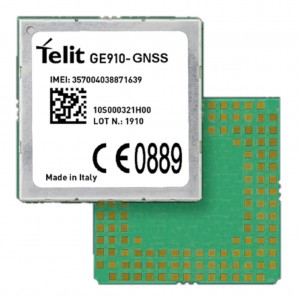The GE910-GNSS combines GSM/GPRS plus GNSS (GPS and GLONASS) in one enclosure. This saves space on PCB and lowers the bill of material.
- QUAD-BAND GSM 850/900 1800/1900 MHz
- GNSS (GPS and Glonass)
- Embedded TCP/IP, FTP, SMTP
- 28.2 x 28.2 x 2.6 mm
- 10 I/O ports max.
- 2 UART, USB2.0, I2C
- Analog/Digital Audio
- Remote AT commands
- LGA footprint like UE910, GE910-Quad and HE910
- Customer code on Python or C
- Lowest power: 1.5 mA @ Idle (registered, power saving on)
- Fully approved: R&TTE, CE, GCF
- Extended temperature range
The GE910-GNSS makes it possible to run the customer’s code inside the module using Python Script Interpreter, thus making it one of the smallest, complete M2M devices.
The GE910-GNSS will also support the Telit AppZone. The Appzone enables easy M2M application development with industry standard C code. The Telit AppZone eliminates the need for an external microprocessor, further reducing the application size and design/integration cost. With the GE910-GNSS and its AppZone the Time to Market will be much faster.
If you would like to have more details about this GSM/GPRS/GNSS Module GE910-GNSS, a free of charge webinar, a study, a research, a prototype or a development of a tracking device, samples or an evaluation kit just send an email to harald.naumann (at) gsm-modem.de

Dear Harald, Is there Rutronik FAE in Italy that support the development of this module?
Maurizio, I am not sure. I am sure that the GE910-GNSS will fit to a lot of my customers in tracking and locating. I plan to combine it with some indoor locating on ANT and/or BLE. Anyhow, the reading of my blog is open for everybody.
Hi
Maybe I am missing something but for the GSM side of the device I can see current consumption as low as 1.2mA for paging multiframe 9.
But the GNSS side only lists:
Tracking GPS: 55mA
Tracking GNSS: 65mA
Acquisition GNSS: 98mA
I dont see any mention of a standby current for the GNSS side?
Hi Chris, the GNSS version will be launched in Jan/Feb 2014. Anyhow the GNSS part is based on Sirfstar V. It offers the lowest power consumption and highest performance as well.